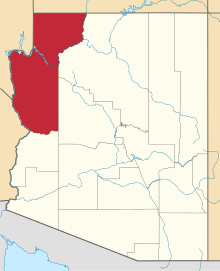Fort Mojave Indian Reservation
| Total population | |
|---|---|
| 1,100 | |
| Regions with significant populations | |
|
| |
| Languages | |
| English, Mojave |
The Fort Mojave Indian Reservation is an Indian reservation along the Colorado River, currently encompassing 23,669 acres (95.79 km2) in Arizona, 12,633 acres (51.12 km2) in California, and 5,582 acres (22.59 km2) in Nevada. Originally established in 1870, the reservation is home to approximately 1,100 members of the federally recognized Mohave Tribe of Native Americans.
Unlike the percentage of occupancy of many other Indian reservations in Arizona, Native Americans occupy less than 50% of the Mojave reservation. The Mohave people have leased much of their land to cotton, corn, and soybean farming companies, which employ a large population of resident white people and Mexican Americans.[1]
The site of the former Fort Mohave, used from 1890 to the 1930s as a boarding school, and the eastern terminus of the Mojave Road are situated within the present-day Fort Mojave Indian Reservation.
History
The Fort Mojave Indian Reservation was established in 1870 more than a decade after the US Army defeated the Mohave people and hostilities were ended. This area was occupied for thousands of years by succeeding cultures of indigenous peoples. The property covers areas along the Colorado River of the three adjacent states of Arizona, California, and Nevada. It also is sporadically traversed by the Mojave River in California.
In 1890 Fort Mohave, located within reservation boundaries, was transferred by the War Department to the Office of Indian Affairs. For decades until the early 1930s, it operated an Indian boarding school for Native American students from the Mohave and other tribes, as part of efforts to assimilate youth to the mainstream culture. They were forced to speak English and practice Christianity while at the school. The property was transferred to the reservation in 1935. It has allowed the buildings to deteriorate, as they were symbolic of a painful period in relations with the US.
In 1929 archeologist Arthur Woodward of the Los Angeles Exposition Museum visited a ranch near Victorville, California. Located near the Mojave River, it was bought by Robert Turner in 1883. Woodward found pottery similar to that of indigenous "lost cities" in Nevada, as well as ancient Indian graves, judging them to be thousands of years old.[2] In 1940 descendant farmer Frank Turner found the Indian graves again during plowing of farmland, not aware of the earlier find. Two deputies called in to see the remains thought the bodies might have been of pioneers. Later assessment confirms they were likely ancient Native Americans, as they were buried in a ritual manner reported in oral tradition.
"According to Frank, the bodies were in a crouching or kneeling position, all facing the [Mohave] river, and all had beads around their necks. There were 26 or 27 bodies altogether, but five or six were in better condition than the others. The remains had been cremated, and buried in the graves with them were large rocks..." [2]
[3] In 1950 a journalist reported this burial practice as typical of indigenous peoples preceding the Paiute and Shoshone.[2]
Economy
The Mojave have leased considerable amounts of reservation land to agricultural companies for cultivation of commodity crops: soybeans, corn, and alfalfa. Many White and Mexican American workers live here, and less than 50% of the reservation is occupied by Mohave and other Native Americans.
On October 20, 2003, the reservation government announced an agreement between the reservation and California Governor Gray Davis to allow the operation of a casino west of Needles, California (directly across the Colorado River from the Tribe's Arizona Reservation Lands). The tribe also operates the Avi Resort & Casino in Nevada.[4]
Language revitalization
As of 2012, The Center for Indian Education at Arizona State University "has facilitated "workshops for both learners and speakers at the Fort Mojave Indian Reservation in northwest Arizona, California and Nevada. Fort Mojave has about 22 elders who speak some Mojave."[5] The project is also bringing elders together with younger people to teach the traditional Mojave "bird songs."[6]
The language preservation work of poet Natalie Diaz on the reservation was featured on the PBS News Hour in March 2012.[7]
Location
The Fort Mojave Indian Reservation is located at 34°56′34″N 114°36′33″W / 34.94278°N 114.60917°WCoordinates: 34°56′34″N 114°36′33″W / 34.94278°N 114.60917°W.[8]
Communities
- Arizona Village, Arizona (part)
- Fort Mohave, Arizona (part)
- Golden Shores, Arizona (part)
- Mesquite Creek, Arizona
- Mohave Valley, Arizona (part, population 121)
- Mojave Ranch Estates, Arizona
- Needles, California (part, population 208)
- Willow Valley, Arizona (part)
References
- ↑ Fort Mojave Reservation and Off-Reservation Trust Land, Arizona/California/Nevada United States Census Bureau
- 1 2 3 Richard D. Thompson; Kathryn L. Thompson (1995). Pioneer of the Mojave: The Life and Times of Aaron G. Lane. Desert Knolls Press. p. 4. ISBN 978-0938121107.
- ↑ The U.S. Geological Survey Geographic Names Information System: Fort Mojave Burial Grounds listing for coordinates is 34°51′06″N 114°37′07″W / 34.85167°N 114.61861°W.
- ↑ Avi Resort & Casino
- ↑ Mary Shinn (2010-11-29). "ASU center bringing new life to Native languages". The State Press. Retrieved 2012-09-11.
- ↑ Pete Zrioka (2012-03-26). "Cultural conservation: keeping languages alive". Arizona State University News. Retrieved 2012-09-11.
- ↑ Mary Jo Brooks (2012-06-20). "On Wednesday's NewsHour: Poet Natalie Diaz". Art Beat PBS NewsHour. Retrieved 2012-09-11.
- ↑ U.S. Geological Survey Geographic Names Information System: Fort Mojave Reservation
External links
- Official Tribe Website
- Fort Mojave Reservation, Northern Arizona University
- Fort Mojave Tribe, InterTribal Council of Arizona


